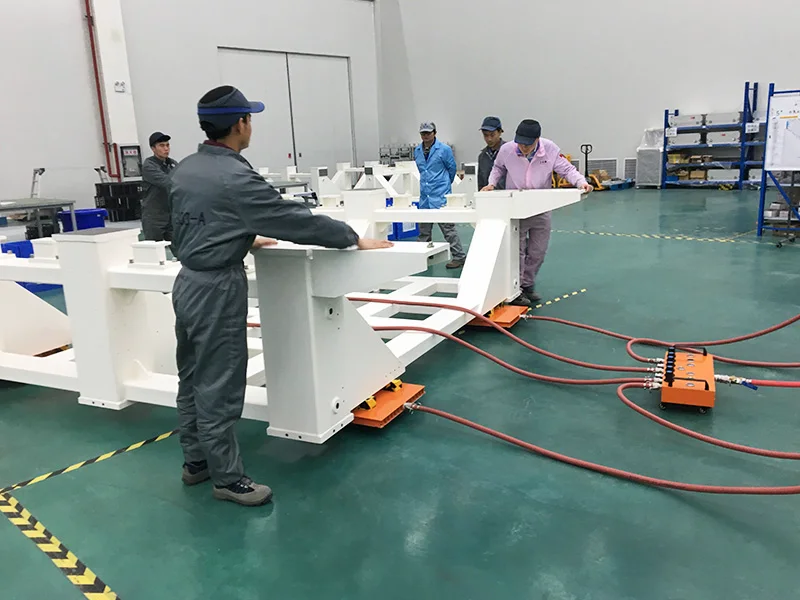
The air casters are the transporters for moving heavy loads; they work on the principle of moving objects by creating an air film. The process of moving the object from one place to another requires specific prerequisites to be fulfilled. Having a smooth surface or floor is crucial because an unsuitable floor can lead to slips and trips that may cause serious injuries. A frictionless surface will provide more efficient results as compared to a surface with cracks and bumps.
Understanding Air Caster Technology
Finer’s air casters are pneumatic devices that can transport weights from 10 tons to 120 tons. The key principle for moving heavy loads is the formation of an air film between the caster surface and the floor. Air casters are very versatile; they can move delicate objects as well as heavy engines of automobiles—the formation of an air film results in frictionless movement of the objects. Every warehouse and industry requires an air caster for moving the loads from one place to another. For an air caster, having a smooth floor surface and finished flooring is the most essential factor for moving heavy loads.
Key Flooring Requirements for Air Casters
The floor of the area where the movement of objects is to take place should have the following characteristics to ensure the process can be conducted efficiently. Here is a detailed list of the factors that a floor must have for the proper operation of air casters.
· Surface Smoothness and Flatness
Air casters form approximately a millimeter of air film between the platform and the floor. The movement is flawless if the floor surface is smooth. It is advised that the floor be adequately finished, made of concrete or marble, and trowelled properly. It is advised that the floor is adequately finished, must be made of concrete or marble and trowelled properly. The hindrance in the movement is due to the presence of pores in the floor surface. The movement of the heavy load using an air caster requires a flat surface for its operation. So, it should be ensured that the surface area of the floor is according to need.
· Surface Strength and Load Capacity
The floor surface needed to be strong enough to support heavy loads. However, there is an advantage to using air bearings, as the load is evenly distributed across the surface. So, the load-bearing capacity of the floor can be low, and the material can be moved from one place to another. The traditional methods for load movement required high surface strength and load capacity. That is not a challenge for air bearings.
· Clean and Debris-Free Conditions
The ideal floor requirements or conditions play a vital role in the movement of heavy loads by air bearings. The floor surface must be clean of all debris and free from dust. The surface must be almost frictionless. An increase in dirt and debris will hinder movement.
· Porosity and Sealing
The floor surface area must be free from any kind of pores and must be adequately sealed. Air casters move by forming a film between the platform and the smooth floor surface. Any sort of crack, pore or loss of seal may result in uneven movement of the material. Cracks or pores in the floor surface can lead to air seal issues that must be adequately filled.
· Levelness and Slope
The movement of a heavy load depends on the surface area, slope, and levelness. As the floor declines, air casters accelerate in speed. The inclination of the floor must be 0.2% in any 10-foot run. Air bearings are more efficient in this regard as well, so the inclination must exceed 0.4 % in any 10-foot run.
Troubleshooting Common Flooring Issues
There are specific issues associated with the floor that may lead to more significant problems. Here is the detail, which is as follows:
· Air Leakage
If there are pores and cracks in the floor surface, then the main issue for the air bearing is air leakage. If there is air leakage from the floor surface, the air film that forms will not be as smooth as required. So, any pores or cracks must be sealed and packed correctly. The floor requirements must be fulfilled for the proper functioning of the air bearings.
· Load Instability
An uneven floor surface causes instability in load distribution. The uneven distribution of the load can result in an uneven formation of the air cushion. That will, in turn, cause uneven movement of a heavy load.
· Floor Damage
Any damage to the floor surface may result in uneven movement of heavy loads. The floor damage will cause friction in the movement of heavy loads. The poorly maintained floor, full of cracks and tears, will make it very difficult to move heavy loads.
Conclusion
The ultimate result with air casters is determined by the quality of the floor on which they are used. Employees should understand that the floor needs to be level, sealed, clean, and able to support the air film. Any imperfections, such as cracks, pores, or uneven surfaces, may result in weak floors, instability, and air leaking out. Sealing and maintaining the floor ensures the air caster system operates efficiently, and the floor lasts for a long time. It is necessary to meet these flooring requirements because the safety, reliability, and efficiency of handling materials depend on them.
